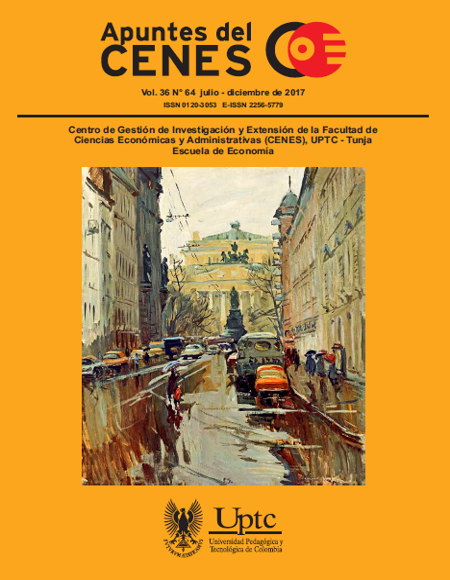The Complexity of Latin-American Stock Market using a Behavioral Cellular Automaton Model

Abstract
The aim of this research is to evaluate the complexity level of Latin-American stock market using a cellular automaton model. For this purpose six indexes are studied: COLCAP, IPSA, MERVAL, MEXBOL, SPBLPGPT and IBOV respectively, during the period 2004 and 2016. The series are analyzed from their statistical behavior, adjustment of returns and estimation of its complexity. The last one is contrasted with the complexity level obtained simulating an artificial stock market model. Concluding that although Latin-American stock markets present differences they have similar tendencies and their complexity level cannot be predicted by a purely behavioral cellular automaton model.
Keywords
behavioral finance, underlying principles, computational techniques, simulation modeling.
Author Biography
Leonardo Hernán Talero Sarmiento
Ingeniero Industrial. Estudiante de Maestría en Ingeniería Industrial. Escuela de Estudios Industriales y Empresariales. Universidad Industrial de Santander
Juan Benjamín Duarte Duarte
Ingeniero Industrial. Doctor en Finanzas de Empresa. Profesor Titular. Escuela de Estudios Industriales y Empresariales. Universidad Industrial de Santander. Carrera 27, Calle 9 – Ciudad Universitaria
Laura Daniela Garcés Carreño
Ingeniera Industrial. Estudiante de Maestría en Ingeniería Industrial. Profesor auxiliar. Escuela de Estudios Industriales y Empresariales. Universidad Industrial de Santander
References
- Atman, A. P. F. & Gonçalves, B. A. (2012). Influence of the Investor’s Behavior on the Complexity of the Stock Market. Brazilian Journal of Physics, 42(1–2), 137–145. https://doi.org/10.1007/s13538-011-0057-7 DOI: https://doi.org/10.1007/s13538-011-0057-7
- Aysen, M. (2015). Argentina y su desarrollo posterior a la crisis financiera. Problemas del Desarrollo, 46(180), 151–174. Recuperado de http://doi.org/10.1016/S0301-7036(15)72123-1 DOI: https://doi.org/10.1016/S0301-7036(15)72123-1
- Bakker, L., Hare, W., Khosravi, H. & Ramadanovic, B. (2010). A Social Network Model of Investment Behaviour in the Stock Market. Physica A: Statistical Mechanics and its Applications, 389(6), 1223–1229. Retrieved from http://doi.org/10.1016/j.physa.2009.11.013 DOI: https://doi.org/10.1016/j.physa.2009.11.013
- Bartolozzi, M. & Thomas, A. W. (2005). Stochastic Cellular Automata Model for Stock Market Dynamics. Physical Review, 73, 1–17. DOI: https://doi.org/10.1103/PhysRevE.73.069901
- Blasco de Las Heras, N. & Santamaría, R. (1994). Memoria a largo plazo en el mercado de valores español: una aproximación a través del análisis R/S. Investigaciones Económicas, 28(3), 571–583. Recuperado de http://ftp.fundacionsepi.es/investigacion/revistas/paperArchive/Sep1994/v18i3a9.pdf
- Duarte, J. B., Garcés, L. D. & Sierra, K. J. (2016). Efecto manada en sectores económicos de las bolsas latinoamericanas: una visión pre y poscrisis subprime. Contaduría y Administración, 61(2), 298–323. Recuperado de http://doi.org/10.1016/j.cya.2015.12.002 DOI: https://doi.org/10.1016/j.cya.2015.12.002
- Duarte, J. B. & Mascareñas, J. M. (2014a). ¿ Han sido los mercados bursátiles eficientes informacionalmente? Apuntes del Cenes, 33(57), 117–146. DOI: https://doi.org/10.19053/22565779.2906
- Duarte, J. B. & Mascareñas, J. M. (2014b). Comprobación de la eficiencia débil en los principales mercados financieros latinoamericanos. Estudios Gerenciales, 30(133), 365–375. Recuperado de http://doi.org/10.1016/j.estger.2014.05.005 DOI: https://doi.org/10.1016/j.estger.2014.05.005
- Fama, E. (1970, May). Efficient Captial Markets: A Review of Theory and Empirical Work. The Journal of Finance, 25(2). Retrieved from http://doi.org/10.1111/j.1540-6261.1970.tb00518.x DOI: https://doi.org/10.2307/2325486
- Fan, Y., Ying, S.-J., Wang, B.-H. & Wei, Y.-M. (2009). The Effect of Investor Psychology on the Complexity of Stock Market: An Analysis Based on Cellular Automaton Model. Computers & Industrial Engineering, 56(1), 63–69. Retrieved from http://doi.org/10.1016/j.cie.2008.03.015 DOI: https://doi.org/10.1016/j.cie.2008.03.015
- Lo, A.W. (1991). Long-Term Memory in Stock Market Prices. Econometrica, 59(5), 1279. Retrieved from http://www.jstor.org/stable/2938368?origin=crossref DOI: https://doi.org/10.2307/2938368
- Lo, A. W. (2005). Reconciling Efficient Markets with Behavioral Finance: The Adaptive Markets Hypothesis. Journal of Investment Consulting, 920(617).
- Malkiel, B. G. & Fama, E. F. (1970). Efficient Capital Markets: A Review of Theory and Empirical Work. The Journal of Finance, 25(2), 383–417. Retrieved from http://doi.org/10.1111/j.1540-6261.1970.tb00518.x DOI: https://doi.org/10.1111/j.1540-6261.1970.tb00518.x
- Mandelbrot, B. (1972). Statistical Methodology for Nonperiodic Cycles: From the Covariance to R/S Analysis. Annals of Economic and Social Measurement, 1(3), 259–290.
- Miranda, R. (2014). Comercio y política: Argentina entre las potencias y las no potencias. Latinoamérica, Revista de Estudios Latinoamericanos, 59, 41–67. Recuperado de http://doi.org/10.1016/S1665-8574(14)71725-9 DOI: https://doi.org/10.1016/S1665-8574(14)71725-9
- Mozafari, M. & Alizadeh, R. (2013). A Cellular Learning Automata Model of Investment Behavior in the Stock Market. Neurocomputing, 122, 470–479. Retrieved from http://doi.org/10.1016/j.neucom.2013.06.002 DOI: https://doi.org/10.1016/j.neucom.2013.06.002
- Qiu, G., Kandhai, D. & Sloot, P. M. A. (2007). Understanding the Complex Dynamics of Stock Markets Through Cellular Automata. Physical Review, 75(4), 46116–11. Retrieved from http://doi.org/10.1103/PhysRevE.75.046116 DOI: https://doi.org/10.1103/PhysRevE.75.046116
- Shiller, R. J. (2003). From Efficient Markets Theory to Behavioral Finance. Journal of Economi Perspectives, 17(1055), 83–104. DOI: https://doi.org/10.1257/089533003321164967
- Sierra, G. (2007). Procesos de Hurst y movimiento browniano fraccional en mercados fractales: Valuación y aplicaciones a los derivados y Finanzas. Monterrey: Instituto Tecnológico de Estudios Superiores de Monterrey.
- Stefan, F. M. & Atman, A. P. F. (2015). Is there Any Connection Between the Network Morphology and the Fluctuations of the Stock Market Index? Physica A: Statistical Mechanics and its Applications, 419, 630–641. Retrieved from http://doi.org/10.1016/j.physa.2014.10.026 DOI: https://doi.org/10.1016/j.physa.2014.10.026
- Villegas, P. H. L. (2016). Latinoamérica ante las transformaciones del orden monetario y financiero mundial. Economía Informa, 396, 67–83. Recuperado de http://doi.org/10.1016/j.ecin.2016.01.004 DOI: https://doi.org/10.1016/j.ecin.2016.01.004
- Wei, Y., Ying, S., Fan, Y. & Wang, B.-H. (2003). The Cellular Automaton Model of Investment Behavior in the Stock Market. Physica A: Statistical Mechanics and its Applications, 325(3), 507–516. Retrieved from http://doi.org/10.1016/S0378-4371(03)00144-4 DOI: https://doi.org/10.1016/S0378-4371(03)00144-4
- Ying, S. & Fan, Y. (2014). Complexity in the Chinese Stock Market and its Relationships with Monetary Policy Intensity. Physica A, 394, 338–345. Retrieved from http://doi.org/10.1016/j.physa.2013.09.047 DOI: https://doi.org/10.1016/j.physa.2013.09.047
- Zhou, T., Zhou, P.-L., Wang, B.-H., Tang, Z.-N. & Liu, J. (2004). Modeling Stock Market Based on Genetic Cellular Automata. Science And Technology, 18, 2697–2702. Retrieved from http://doi.org/10.1142/S0217979204025932 DOI: https://doi.org/10.1142/S0217979204025932
